

|
Problem |
|
Anyone beyond a beginning birder automatically identifies the birds
at the top of this page as Eared Grebes on these characters:
|
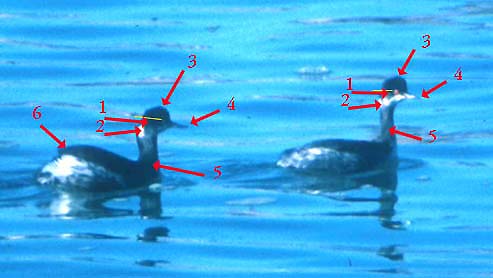 |
The problem arises when a somewhat distant grebe (right) seems to show
|
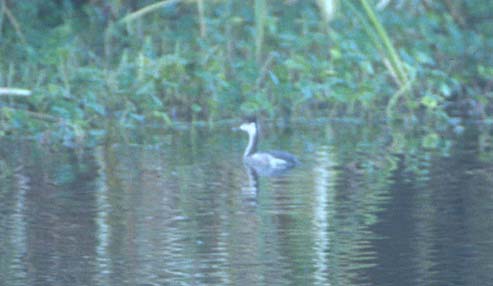 |
 |
Here is a closer view of the Crespi grebe. What looked like clean white cheeks prove to be streaked with dusky and the auriculars are smudged a little, but it is easy to see how the whole lower face could look 'clean white' at a distance. This photo shows the bird perhaps a little more concerned about the nearby photographer, and the head shape looks more 'alert' and peaked above the eye. |
| For comparison, here is a real Horned Grebe in basic plumage. The cheeks
(and everything on the face below the line of the eye) are really clean
white. The front of the neck really is white. The crown is more rounded,
and where the peak of the body is held on the back is well forward of the
typical 'high rear end' of Eared Grebe. Also the flanks look white (not
gray as above) but they also looked streaked here.
This Horned Grebe has a red eye while the Eared Grebe on Crespi has a yellow eye. This is age related (more below) HOGR photo © D. Roberson 15 Nov 2004 Monterey harbor |
 |
| Below are two shots of the other misidentified 'Horned Grebe' in MTY. It was on fresh-water Roberts Lake on 23 Oct 2004, and was reported by experienced birders. At a distance (below left) it does look to have white cheeks but up closer (below right) a lot of smudging or streaking appears in the cheeks and the top of the neck has a lot of dusky in the front. It's head looks rather rounded and it is not carrying its rear end high. Again, it is easy to see why a quick glance would bring a "Horned Grebe" response for this bird. It also has a yellow eye. Photos © D. Roberson |
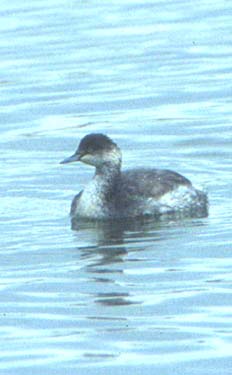 |
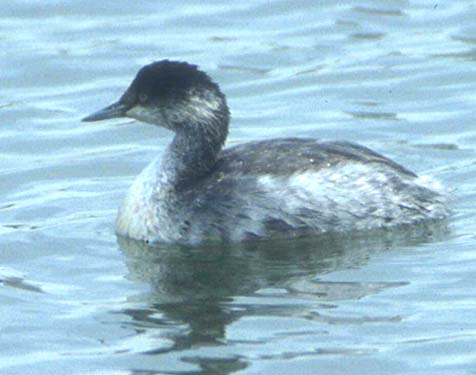 |
|
As illustrated below with enlargements on the heads of some of the above birds, all Horned Grebes have a distinctive white tip to the bill while Eared Grebes do not. The bill shape of Eared Grebe shows a very slight up-turn while that of Horned Grebe very slight turns down at the tip; these differences are exaggerated by the shape of the bottom edge of the lower mandible (slightly upturned from the gonys in Eared, rather straight in Horned) so that even when the culmen is actually straight in some Eared Grebes (like that on Roberts Lake) the slight up-turn of the curvature of the lower mandible gives a slightly upturned look. |
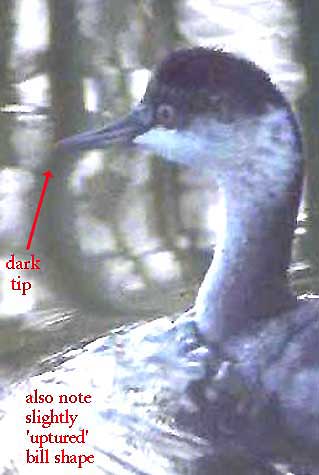 |
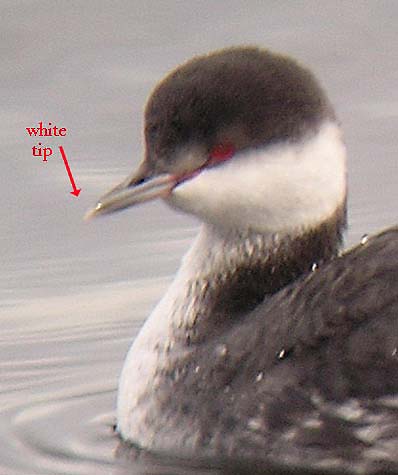 |
|
|
|
My experience with misidentified Eared Grebes is with just these two fall birds in Monterey. Both were yellow-eyed birds. Thus I speculate that:
|
Literature cited:
| I hadn't appreciated this problem until Jim Gain, Harold Reeve and
I saw an odd grebe at the Madera sewage ponds during a 12 September 04
big day. It was quite close and showed many features of a Horned
Grebe: a clean white cheek, a mostly white foreneck, a low "stern," a smooth
and nearly flat crown, and even an apparently straight bill with a white
tip. Despite their initial skepticism I had pretty much convinced Harold
and Jim that we were looking at a Horned Grebe. We all felt uneasy about
this claim, however, as the bird didn't seem typical to us; it didn't have
the bulky body of a Horned, and the white and dark of its plumage didn't
contrast as crisply as it should have. I then found another nearly identical
grebe, then two more, and two more. Only then was it obvious that we were
looking at first-fall Eared Grebes.
So I'd say many if not all first-fall Eared Grebes have this confusing plumage before they complete their first prebasic molt, which according to the Birds of North America account by Cullen et al. (1999) "continues into October or later," and even birds at close range can be a problem. That we thought the bird had a straight bill with a white tip, suggests even these features may not be foolproof: If fools like us can get it wrong, others can too. Head shape, and especially the slope of the rump, could vary with a bird's attitude, but I don't know what accounts for this bird's apparently straight and white-tipped bill. The bird was actively diving, so perhaps the bill looked as it did because it was wet. Or maybe the difference between slightly upturned and dark-tipped and slightly down-turned and white-tipped is just not obvious in many field situations. We should always first consider Eared Grebe when we see a small Podiceps on fresh water, but it does seem especially prudent to do this in September- October. And based on the Madera experience, I think body bulk and plumage contrast may be as important in distinguishing the two grebes as the features you suggested. |
Use the following links to other portions of the MTY checklist:
Part 1: Waterfowl through GrebesReaders may use this material for their own private enjoyment, study, or research but none of the photos or text herein may be used commercially nor may they be reposted on other web sites without written permission. All material is copyrighted. The posting of photos and text on this private web site is not a submission to review organizations.
Part 2: Albatrosses through Frigatebirds
Part 3: Herons through Cranes
Part 4: Plovers through Sandpipers
Part 5: Jaegers through Alcids
Part 6: Doves through Woodpeckers
Part 7: Flycatchers through Larks
Part 8: Swallows through Pipits
Part 9: Waxwings through Warblers
Part 10: Tanagers through Sparrows
Part 11: Grosbeaks through Finches
or just the plain Checklist (no annotations)